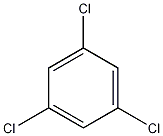
Structural formula
| Business number | 02XS |
|---|---|
| Molecular formula | C6H3Cl3 |
| Molecular weight | 181.45 |
| label |
Symmetric trichlorobenzene, Trichlorobenzene, Sym-trichlorobenzene, 1,3,5-Trichloro-benzen, Ai3-22031, Benzene,1,3,5-trichloro-, s-Trichlorobenzene, Trichloro-1,3,5benzene, 1,3,5-TCB |
Numbering system
CAS number:108-70-3
MDL number:MFCD00000585
EINECS number:203-608-6
RTECS number:DC2100100
BRN number:1635233
PubChem ID:None
Physical property data
1. Characteristics: white crystal with special smell. [1]
2. Melting point (℃): 63.4[2]
3. Boiling point (℃): 208.5 [3]
4. Relative density (water = 1): 1.356 (100℃) [4]
5 .Relative vapor density (air=1): 6.26[5]
6. Saturated vapor pressure (kPa): 1.33 (78.0℃)[6]
7. Critical pressure (MPa): 3.72[7]
8. Octanol/water partition coefficient: 4.19[8 ]
9. Flash point (℃): 107[9]
10. Ignition temperature (℃): 577[10]
11. Solubility: Insoluble in water, slightly soluble in ethanol, easily soluble in ether and benzene. [11]
12. Gas phase standard entropy (J·mol-1·K-1): 362.83
13. Gas phase standard hot melt (J·mol-1·K-1): 129.17
Toxicological data
1. Acute toxicity: rat oral LD50: 800mg/kg; mouse oral LD50: 3350mg/kg; mouse abdominal LD50: 2260mg/kg;
2. Other multiple doses Toxicity: Oral TDLo in rats: 7380mg/kg/13W-C;
3. Parenteral dominant lethality test of mutagenic insects: 10ppm; Dominant lethality test of skin contact with insects: 10ppm; mouse intraperitoneal micronucleus test: 425mg/kg/24H;
4. Acute toxicity [12] LD50: 800mg/kg (orally in rats); 2260mg/kg (orally in mice)
5. Irritation [13]
Rabbit transdermal: 500mg (24h), mild stimulation.
Rabbit eye: 100mg, mild irritation.
6. Mutagenicity [14] Micronucleus test: mice were given 425mg/kg intraperitoneally (24h)
Ecological data
This substance may be harmful to the environment and it is recommended not to let it enter the environment.
Molecular structure data
1. Molar refractive index: 40.93
2. Molar volume (cm3/mol): 125.2
3. Isotonic specific volume (90.2K ): 314.8
4. Surface tension (dyne/cm): 39.9
5. Polarizability (10-24cm3): 16.22
Compute chemical data
1. Reference value for hydrophobic parameter calculation (XlogP): None
2. Number of hydrogen bond donors: 0
3. Number of hydrogen bond acceptors: 0
4. Number of rotatable chemical bonds: 0
5. Number of tautomers: none
6. Topological molecule polar surface area 0
7. Number of heavy atoms: 9
8. Surface charge: 0
9. Complexity: 63.3
10. Number of isotope atoms: 0
11. Determine the number of atomic stereocenters: 0
12. Uncertain number of atomic stereocenters: 0
13. Determine the number of chemical bond stereocenters: 0
14. Number of uncertain chemical bond stereocenters: 0
15. Number of covalent bond units: 1
Properties and stability
1. Stability[15] Stable
2. Incompatible substances[16] Strong oxidizing agent
3. Conditions to avoid contact[17] Heating
4. Polymerization Hazards[18] No polymerization
5. Decomposition products[19] Hydrogen chloride
Storage method
Storage Precautions[20] Store in a cool, ventilated warehouse. Keep away from fire and heat sources. The packaging is sealed. They should be stored separately from oxidants and food chemicals, and avoid mixed storage. Equipped with the appropriate variety and quantity of fire equipment. Suitable materials should be available in the storage area to contain spills.
Synthesis method
1. Pyrolysis method: The dried nontoxic body of 666 is heated in a pyrolysis kettle to obtain trichlorobenzene, and a large amount of hydrogen chloride is produced as a by-product.
2. Alkaline hydrolysis method: Trichlorobenzene is obtained by heating the nontoxic body of 666 with lime milk, and a large amount of calcium chloride liquid is produced as a by-product. The trichlorobenzene obtained by the above two methods is a mixture of three isomers: 1,2,4-trichlorobenzene; 1,3,5-trichlorobenzene; 1,2,3-trichlorobenzene. , 4-trichlorobenzene is the main component. Among the trichlorobenzene produced by the lime milk method, the content of 1,2,4-trichlorobenzene is more than 75%, and 1,2,3-trichlorobenzene accounts for about 20%.
Purpose
1. Can be used as a solvent to prepare pesticides, dyes, medicines, electrolytes, lubricants, etc. Used in organic synthesis, pesticide and dye synthesis.
2. Used in organic synthesis, pesticide and dye synthesis. [21]



 微信扫一扫打赏
微信扫一扫打赏
